Rewrite Text in English and 100+ Other Languages

[yop_poll id=”2″]
Today is an exciting day for wordbot.io, with the website taking a significant step forward in its journey to becoming the World’s best rewriting tool. Beginning today, wordbot.io can officially rewrite sentences, paragraphs, essays and articles in over 100 languages. 109 languages to be exact including English, Spanish, French, Italian, German, Arabic, Chinese.
If you need to rewrite into a foreign language, wordbot has just become a must have. The new feature is super simple to use. Let’s take a look at it, but before we do I want to mention at the bottom of this post you’ll find the full list of the 109 languages that wordbot now supports.
How To Use wordbot’s Foreign Language Rewrite Feature
To show how this awesome new feature of wordbot works, I did a little translation exercise. In reality, most of us will want to write and rewrite in the same language. For example, I will always write and rewrite in English while someone else may always work in Italian or Spanish, etc. But, to show the flexibility of this feature, for this example I chose to rewrite English text in Italian, Italian in Chinese, and then rewrite text in English from Chinese to come full circle. Let’s get started explaining the screenshots.
Set Your Default Language in Account Settings
After logging into wordbot.io, click the Settings gear icon. If your default language for both writing and rewriting is English, you’re all set and can skip this step. If not, change the “I’ll be writing in” language to the language you write in and the “and rewriting in” language to the language you will be rewriting your content in.
For example, if you always work in Spanish, you would change both of these settings to Spanish. Then, throughout the wordbot tool it will always work in Spanish both expecting you to write in Spanish and also producing your rewritten sentences in Spanish.
If you primarily work on rewriting text in English from Spanish, you could set these to Spanish and English and wordbot would always expect your writing to be in Spanish and while producing your rewrites in English.
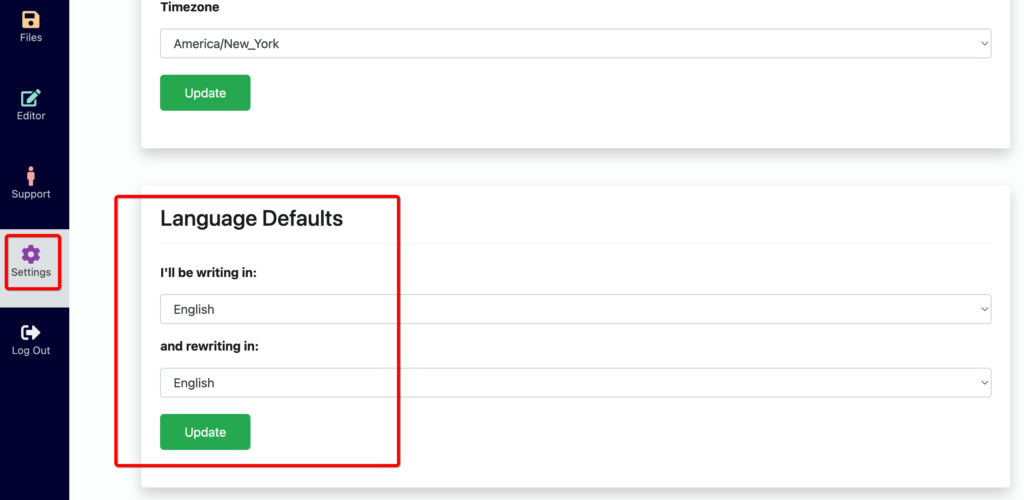
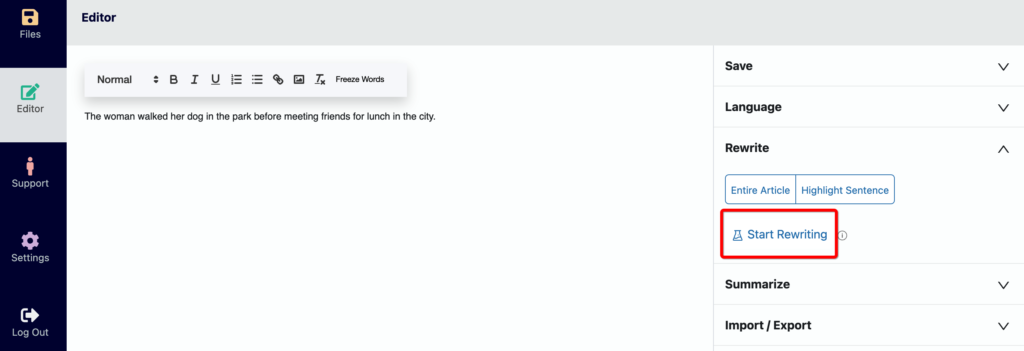
Rewrite English Text to Italian
To begin our example, I left my settings at English / English. I then clicked the Editor icon to enter the text editor. I typed a simple sentence in English. On the right side of the editor, you’ll now notice a Language tab which is minimized by default. This tab allows you to override your account’s language settings on a file by file and editor by editor basis. I’m going to open the tab and override my “rewriting in” language to Italian because I want to rewrite my English sentence into Italian. See below.
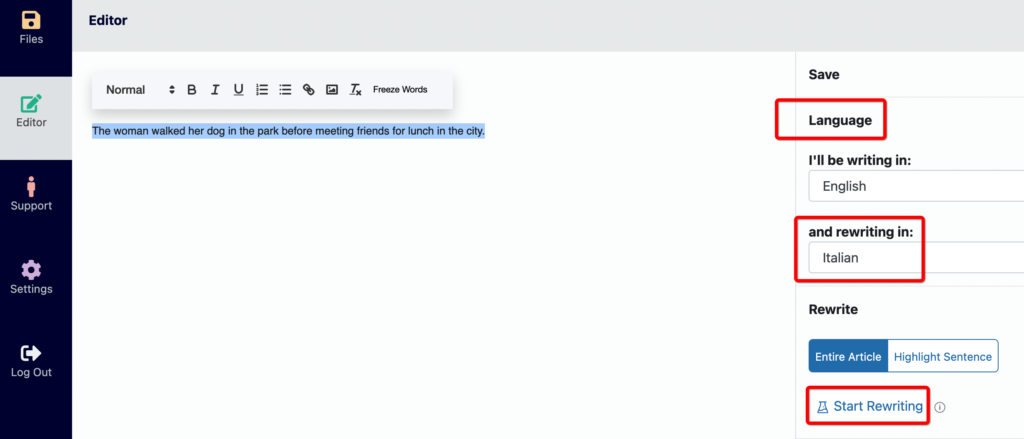
Rewriting My Italian Sentence to Chinese
As we can see below, wordbot has taken my English sentence and rewritten it three times, giving me three Italian paraphrases to choose from. I simply click on one for our example, close the sentence box, and wordbot completes the rewrite and places the Italian in the editor.
One thing to note – you can click on any word within a paraphrase and get a list of synonyms for the word. The synonym list also gets translated and in this example would be in Italian. Freeze words are also honored, but must be entered in the language that you will be rewriting in.
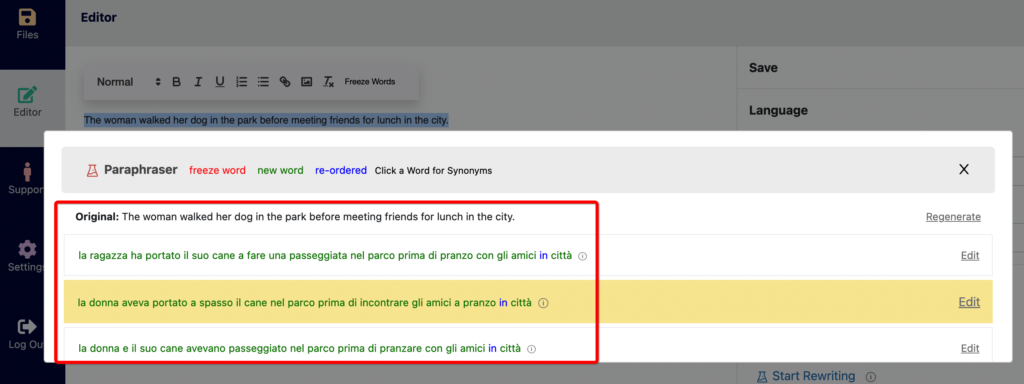
Next, We Rewrite Our Sentence In Chinese
After rewriting the English to Italian and closing the sentence box, I was left with the Italian sentence in the editor. Now, I once again open the Language tab, but this time select Italian in the “writing in” field and Chinese in the “rewriting in” field. I then highlight the Italian sentence and click Start Rewriting.
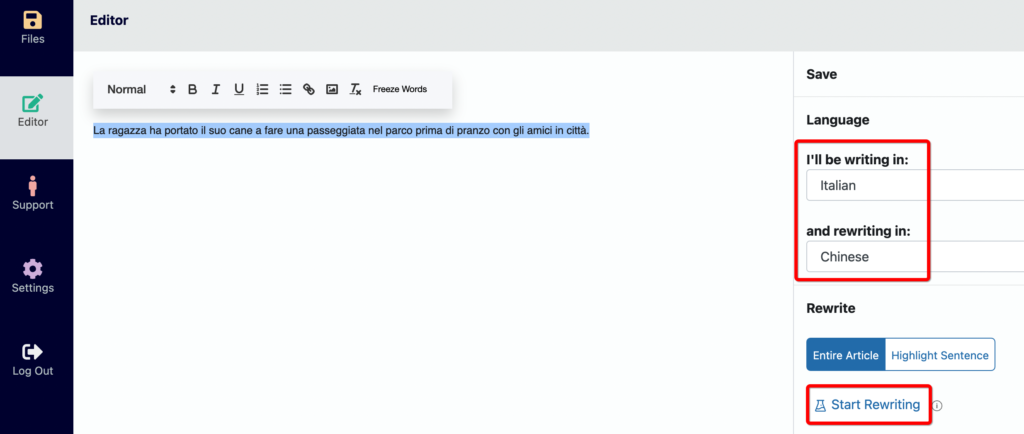
Chinese Paraphrases
Just like the English to Italian example, I’m given three Chinese paraphrases for my Italian sentence. I can select the best and continue on.
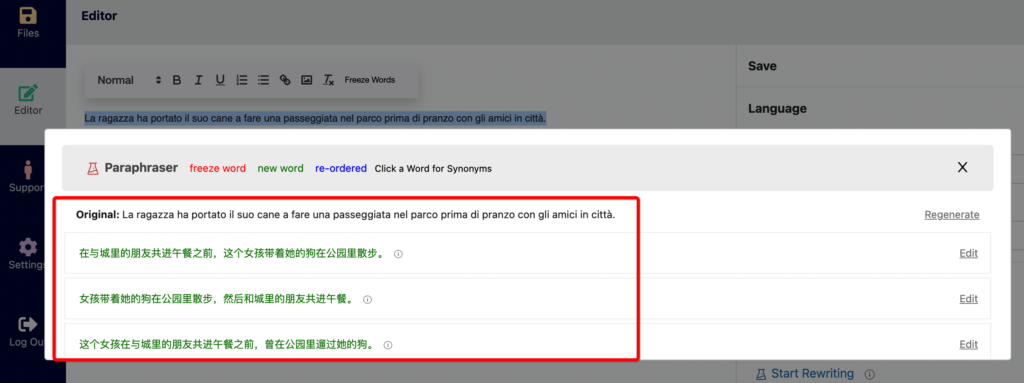
Rewrite Text in English, Coming Full Circle
To bring our example for circle and show how good the rewriting and translating can be, I once again open my Language tab. I change “writing in” to Chinese and “rewriting in” to English, highlight the sentence, and click Start Rewriting. I’m then presented with three English Paraphrases.
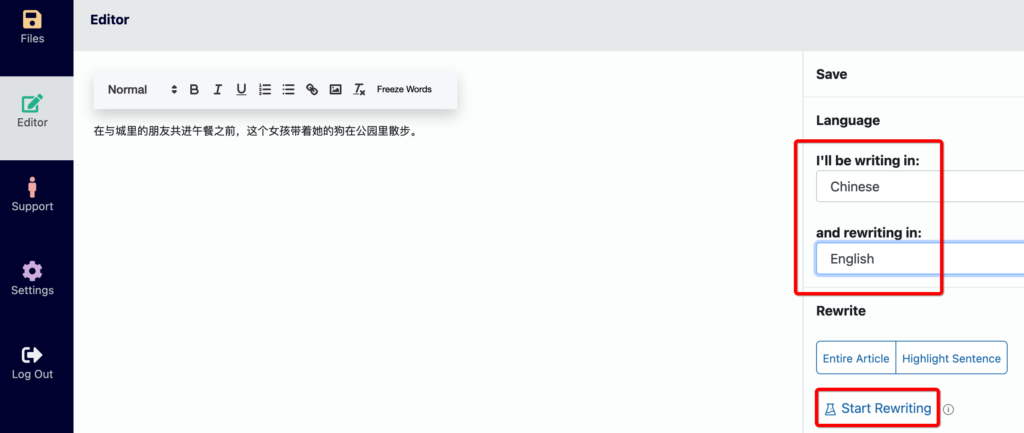
So, How Did Wordbot Do Rewriting the Sentence?
Here we are, after multiple languages, we’re back to English. If you remember, the original English sentence was “The woman walked her dog in the park before meeting friends for lunch in the city.”
Look at the three English paraphrases in the screenshot below. I would say wordbot.io nailed them. This sentence went through English, Italian, Chinese, and back to English and in the end produced three excellent paraphrases – with no manual editing. We of course could manually edit and swap some synonyms to get an even better paraphrase with a larger delta, but very impressive results.
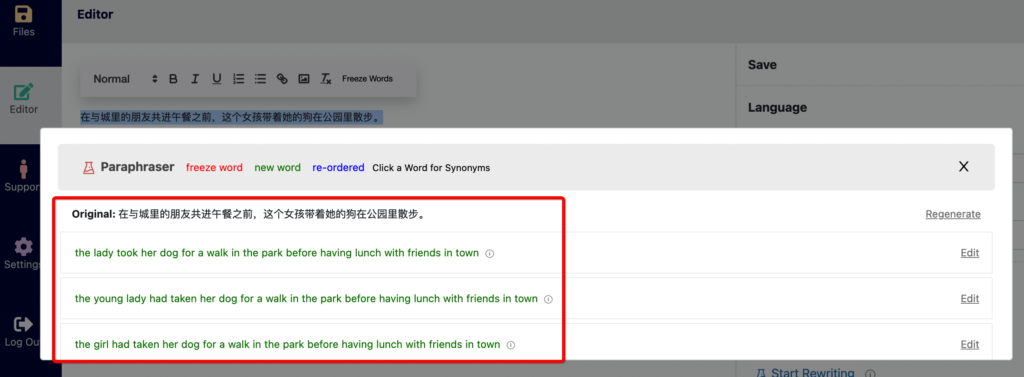
Summary
In closing, we’re very excited about wordbot’s new ability to support over 100 languages when writing and rewriting text. We’ve just started scratching the surface on the development and features that will be included in wordbot, but we’re listening to our customers and making great strides.
Foreign language support is another major step toward transforming wordbot.io from a small bootstrapped MVP to the world’s best text rewriter. Thanks for reading and check out all the supported languages below.
Supported Language List
wordbot.io can recognize and rewrite text FROM any of the below languages INTO any of the below languages. For example, you can write and rewrite solely in Spanish, or you can write in Spanish and rewrite text in English, etc.
- Afrikaans
- Albanian
- Amharic
- Arabic
- Armenian
- Azerbaijani
- Basque
- Belarusian
- Bengali
- Bosnian
- Bulgarian
- Catalan
- Cebuano
- Chichewa
- Chinese
- Corsican
- Croatian
- Czech
- Danish
- Dutch
- English
- Esperanto
- Estonian
- Filipino
- Finnish
- French
- Frisian
- Galician
- Georgian
- German
- Greek
- Gujarati
- Haitian Creole
- Hausa
- Hebrew
- Hindi
- Hmong
- Hungarian
- Icelandic
- Igbo
- Indonesian
- Irish
- Italian
- Japanese
- Javanese
- Kannada
- Kazakh
- Khmer
- Kinyarwanda
- Korean
- Kurdish
- Kyrgyz
- Lao
- Latin
- Latvian
- Lithuanian
- Luxembourgish
- Macedonian
- Malagasy
- Malay
- Malayalam
- Maltese
- Maori
- Marathi
- Mongolian
- Myanmar
- Nepali
- Norwegian
- Odia
- Pashto
- Persian
- Polish
- Portuguese
- Punjabi
- Romanian
- Russian
- Samoan
- Scots
- Serbian
- Sesotho
- Shona
- Sindhi
- Sinhala
- Slovak
- Slovenian
- Somali
- Spanish
- Sundanese
- Swahili
- Swedish
- Tajik
- Tamil
- Tatar
- Telugu
- Thai
- Turkish
- Turkmen
- Ukrainian
- Urdu
- Uyghur
- Uzbek
- Vietnamese
- Welsh
- Xhoas
- Yiddish
- Yoruba
- Zulu






